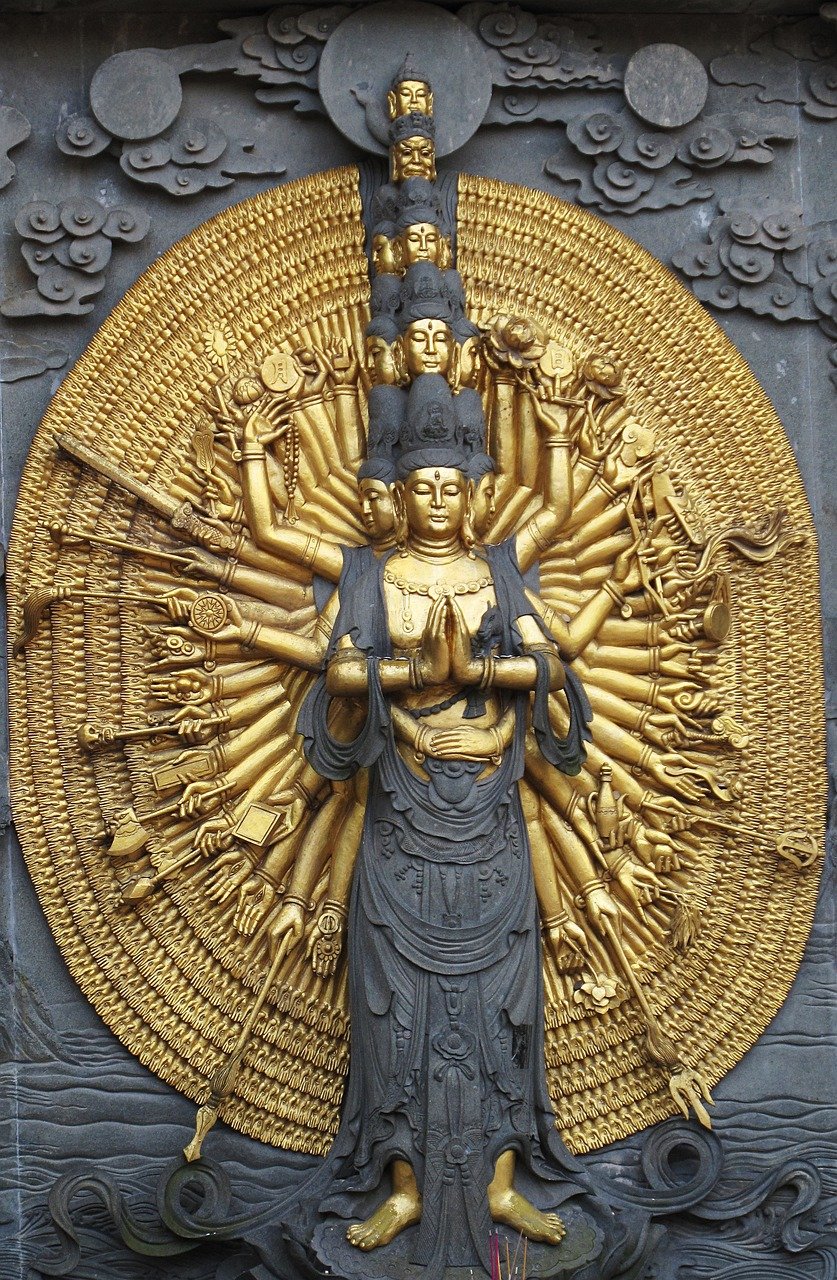Exploring Philosophical Eschatology: Cosmology, Creation, and End Times Across Global Beliefs - Nyingma Lineage of Vajrayana Buddhism
Avalokiteshvara - Bodhisattva of Compassion
Image by Andrew Barker from Pixabay
Exploring Vajrayana Buddhism in the Nyingma Lineage
In our ongoing exploration of philosophical eschatology, we delve into one of the most mystical branches of Buddhism—Vajrayana Buddhism within the Nyingma Lineage. This tradition, deeply rooted in esoteric practices, offers a unique lens for understanding symbols and their profound spiritual implications.
The Three Main Schools of Thought in Buddhism
Buddhism encompasses three primary schools of thought: Theravāda, Mahayana, and Vajrayana. Each tradition presents distinctive approaches to the path of enlightenment.
Here is a concise description of each:
1. Theravāda (The Teaching of the Elders)
Focus: Preserving the original teachings of the Buddha, as recorded in the Pali Canon.
Practice: Emphasizes individual liberation (nirvana) through meditation, ethical conduct, and insight into the nature of reality.
Key Feature: Followers strive to become arhats—individuals who achieve enlightenment through personal effort.
Regions: Predominantly practiced in Sri Lanka, Thailand, Myanmar, Laos, and Cambodia.
View on the Buddha: Seen primarily as a historical figure and teacher.
2. Mahayana (The Great Vehicle)
Focus: Universal liberation of all beings, emphasizing compassion and wisdom.
Practice: Encourages the bodhisattva path, where enlightened beings delay their personal nirvana to help others achieve liberation.
Key Feature: Introduces concepts such as emptiness (śūnyatā) and the interdependence of all phenomena.
Regions: Found mainly in China, Japan, Korea, and Vietnam.
View on the Buddha: The Buddha is regarded as more than a historical figure, often seen as a transcendent, eternal presence.
3. Vajrayana (The Diamond Vehicle)
Focus: Employing esoteric practices and rituals to achieve enlightenment more rapidly.
Practice: Uses tantric techniques, including mantras, mudras (hand gestures), mandalas (visual aids), and deity visualizations.
Key Feature: Requires guidance from a qualified teacher (guru) and emphasizes the union of wisdom and compassion.
Regions: Primarily practiced in Tibet, Bhutan, Mongolia, Nepal, and India.
View on the Buddha: The Buddha is seen as a cosmic figure, revealing the ultimate nature of reality.
Though these schools share foundational principles—such as the Four Noble Truths and the Eightfold Path—they differ in emphasis, interpretations, and practices. This article focuses on the Nyingma lineage of Vajrayana Buddhism, but understanding these divisions provides essential context.
Origins and Spread of Vajrayana
Vajrayana Buddhism, often referred to as Tantric Buddhism or Esoteric Buddhism, originated as an offshoot of the Mahayana tradition in northern India around the 7th century. The Nyingma school emerged when the Indian master Padmasambhava (Guru Rinpoche) brought Vajrayana teachings to Tibet in the 8th century, at the invitation of King Trisong Detsen. This school became the oldest of Tibet’s four major Buddhist traditions. Today, Nyingma practices thrive in Tibet, Bhutan, Nepal, and among Tibetan communities worldwide.
Core Beliefs of the Nyingma Lineage
The Nyingma lineage emphasizes the possibility of achieving enlightenment within a single lifetime through specific esoteric practices.
Here are its key tenets:
Buddha-Nature: All beings inherently possess Buddha-nature—the potential for enlightenment. Vajrayana practices aim to uncover this nature, transcending ordinary perceptions.
Tantra and Mantra: Tantric techniques—mantras, mudras, and mandalas—are central to transforming consciousness and directly experiencing ultimate reality.
Deity Yoga: Practitioners visualize themselves as deities, embodying enlightened qualities. This is a transformative practice rather than an act of worship.
Dzogchen (Great Perfection): A unique, advanced teaching in the Nyingma tradition. Dzogchen focuses on the direct realization of one’s true nature, often described as the most direct path to enlightenment.
Major Deities in Nyingma
The Nyingma lineage features a pantheon of deities representing enlightenment's various aspects.
Key figures include:
Guru Padmasambhava: Revered as the second Buddha and the founder of Vajrayana practices in Tibet.
Vajrayogini: A female Buddha representing the transformation of mundane experiences into spiritual insight.
Avalokitesvara (Chenrezig): The bodhisattva of compassion, widely venerated for cultivating universal compassion.
Vajrakīla (Dorje Phurba): A wrathful deity invoked to overcome obstacles and dispel negative forces.
Samantabhadra (Kuntuzangpo): The primordial Buddha, symbolizing the Dharmakaya (truth body) and the essence of all Buddhas.
Foundations of Buddhist Cosmology
Buddhist cosmology provides a profound moral and spiritual framework, illustrating the effects of karma, samsara (cycle of rebirth), and the path to liberation.
Key elements include:
The Three Realms (Trailokya):
Desire Realm (Kāma-loka): Dominated by desire, including humans, animals, and various spirits.
Form Realm (Rūpa-loka): Higher heavens with subtle, desire-free forms.
Formless Realm (Arūpa-loka): Pure consciousness beyond material existence.
Six Destinies: Within the Desire Realm, beings are reborn into six states based on karma:
Hell Beings (Naraka): Torment and suffering.
Hungry Ghosts (Preta): Insatiable hunger and thirst.
Animals: Instinct-driven existence.
Humans: Balanced potential for enlightenment and suffering.
Asuras (Demigods): Strife and jealousy.
Devas (Gods): Temporary bliss.
Mount Meru: A mythical mountain at the universe’s center, surrounded by continents and oceans, symbolizing cosmic balance.
Cycles of Time (Kalpa): Time is cyclical, with vast kalpas marking creation, existence, decay, and renewal.
Understanding Buddhist Creation Myths
Buddhism’s creation myths emphasize moral and karmic principles over divine acts.
Notable examples include:
The Aggañña Sutta: Describes the formation of worlds and beings, focusing on how desires shape society and existence.
Kalpa Cycles: Illustrates the endless, beginningless nature of samsara.
Role of Deities: Gods like Brahma or Indra assist beings but remain subject to karma and samsara.
These myths reflect Buddhism’s cyclical view of existence, emphasizing morality, transformation, and the journey to enlightenment.
By exploring Vajrayana Buddhism through the lens of the Nyingma lineage, we uncover profound teachings that resonate with modern spiritual quests. Join us next time at avyaktaskye.com as we continue to delve into ancient wisdom and its relevance today.
Thank you for joining me on this journey into global belief systems.
Peace and Blessings,
♥️ Skye


